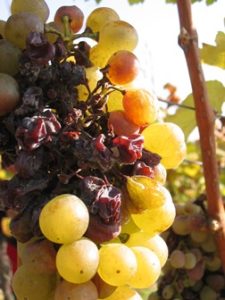The secrets of Tokaji Aszú

The Tokaji wine range
There are dry wines, late harvest wines made from ripe grapes with no noble rot. Wines made from late harvested grapes but without individual selection are called Szamorodni; grapes are pressed directly. Tokaji Aszú 5 or 6 puttonyos is made using special vinification of aszú berries, and the wine contains a minimum of 120 grams sugar per litre and has minimum barrel and bottle ageing.
Tokaji Eszencia
Tokaji Eszencia is born from free run juice from the weight of the aszú berries when they are stored in vats before making the Aszú. The fermentation is very slow due to the high sugar concentration (500 – 900 g/l). The alcohol is minimal, between 1.5 to 3 %. In the old days Eszencia was sold in pharmacies due to its beneficial effect on human health.
The world’s greatest botrytised wines

There are some other sweet wines made from grapes affected by the fungus Botrytis cinerea that causes noble rot in the berries. For example, the most famous one is Sauternes; others are Monbazillac and Passito da Minis, but none has the same characteristics as Tokaji Aszú. For example in Ruszt (Ausbruch) they use similar technology as in Tokaj, but they do the maceration with must / stum in fermentation. Then they age the wine at barrique barrels for between 6 to 8 months or in stainless steel tanks for between 6 to 12 months. While in Sauternes and Barsac noble rot caused by Botrytis is common, the whole bunch is harvested and processed together before fermentation in barrels.
TOKAJI ASZÚ
Tokaj Wine Region is world famous for its unique quality wine, Tokaji Aszú. The secret of Aszú is based in the unique terroir; the climate, Botrytis cinerea, the soil and the traditional method of producing Aszú wine.
“Aszú is a leading product in Tokaj, this is the specialty of the wine region; this is what made Tokaj great. Aszú is positioned very high, it is among the world’s prime products so we determined it must contain a minimum of 120 grams of residual sugar. Szamorodni is contain an average of 110 grams of residual sugar. In addition to sweet wines, very fine, dry wines can be produced as well.” Miklós Prácser
The Aszú berry

Aszú grapes are botrytised grapes that dry on the vine stock and are fundamental to Aszú wines. Extremely rich in sugars, flavours and acids, these dried grapes are formed by two processes: botrytisation, when grapes are attacked by Botrytis that causes noble rot, and shrivelling, when the berries become more concentrated by drying.
The harvest

The aszú berries are each picked one by one during several selections (3 to 4) in the vineyards. One person can pick a mere 5-10 kg a day, and 5 kg of healthy grapes are needed for the development of 1 kg of aszú berries. The individually selected aszú berries are stored in vats until the harvest is completed.
Aszú wine making
Maceration
The skin contact between the aszú berries and a base wine/must (maceration).
Since the berries are almost dry it is impossible to press them directly, thus the use of maceration to extract the sugars, flavours and acids. Aszú berries are soaked in fermenting must or new wine for 12 to 60 hours. The proportion of the aszú berries compared to the base wine or must determines the concentration of the wine; the more aszú berries are added, the richer the Aszú wine.
In the old days the quantity of aszú berries was measured using the puttony (27-litre hod or basket) and the volume of base wine/must using the Gönci barrel (136 litres). Between 3 and 6 hods of aszú grapes were lightly trodden underfoot and then macerated in 136 l of wine or must. Today the number of Puttonyos corresponds to the level of residual sugar and indicates the richness; the concentration of Aszú wines is denoted as 5 or 6 puttonyos Aszú.
Pumping over or pigeage is used to increase skin contact. During maceration the aszú berries form a paste that is then slowly pressed. The juice is racked off to ferment until the wine reaches the desired balance. The nature of the aszú berries determines whether we use fermenting must or base wine and from which vineyard, the proportion of aszú berries and the length of their maceration.
Fermentation
The fermentation of the base wine is made in cool tanks or even in oak barrels.
Maturation

After fermentation in stainless steel, the Tokaji Aszú wines are aged in small oak barrels in deep underground cellars dug into the rock. These cool cellars have a constant temperature of 11 to 13°C with humidity of around 85-90%. The walls are usually covered with a microflora: Cladosporium cellare (Zasmidium cellare). The wines are aged for a minimum of 3 years, at least 2 of which are in oak barrels.
Old style
The real classic old style is very different to the so called old style Aszú. Some winemakers still practise it and have beautiful Aszú wines. They do not really control fermentation. Right after they finish maceration, they press the aszú dough and put the wine into barrels. The wine is fermented for several years. Not intensively but continuously. Since carbon dioxide keeps being generated, it does not oxidize too much. It remains relatively fresh, maintaining its dried fruit aromas. They use less sulphur so it causes darker colour.
New style
The new styled producers pay attention to the fermentation by trying to reach slightly higher alcohol and, as a consequence, less residual sugar. They add much sulphur that causes lighter colour.

Aszús, you can read about:



